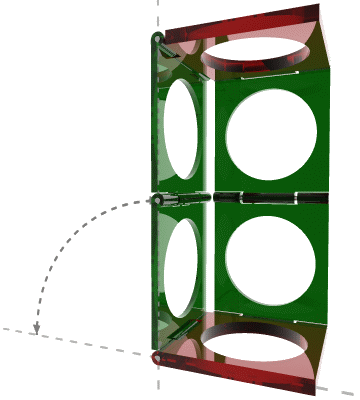 | ||
An overconstrained mechanism is a linkage that has more degrees of freedom than is predicted by the mobility formula. The mobility formula evaluates the degree of freedom of a system of rigid bodies that results when constraints are imposed in the form of joints connecting the links.
Contents
If the links of the system move in three-dimensional space, then the mobility formula is
where N is the number of links in the system, j is the number of joints, and fi is the degree of freedom of the ith joint.
If the links in the system move planes parallel to a fixed plane, or in concentric spheres about a fixed point, then the mobility formula is
If a system of links and joints has mobility M=0 or less, yet still moves, then it is called an overconstrained mechanism.
Sarrus linkage
A well-known example of an overconstrained mechanism is the Sarrus mechanism, which consists of six bars connected by six hinged joints.
A general spatial linkage formed from six links and six hinged joints has mobility
and is therefore a structure.
The Sarrus mechanism has mobility M=1, rather than M=0, which means it has a particular set of dimensions that allow movement.
Bennett's linkage
Another example of an overconstrained mechanism is Bennett's linkage, which consists of four links connected by four revolute joints.
A general spatial linkage formed from four links and four hinged joints has mobility
which is a highly constrained system.
As in the case of the Sarrus linkage, it is a particular set of dimensions that makes the Bennett linkage movable.
The dimensional constraints that makes Bennett's linkage movable are the following. Let us number the links in order that links with consecutive index are joined (first and fourth links are also joined). For the i-th link, let us denote by di and ai respectively the distance and the oriented angle of the axes of the revolute joints of the link. Bennett's linkage must satisfies the following constraints:
Moreover, the links are assembled in such a way that, for two links that are joined together, the common perpendicular to the joint axes of the first link intersects the common perpendicular of the joint axes of the second link.
Below is an external link to an animation of a Bennett's linkage.
Assembly of cognate linkages
Overconstrained mechanisms can be also obtained by assembling together cognate linkages; when their number is more than two, overconstrained mechanisms with negative calculated mobility will result. The companion animated GIFs show two types of overconstrained mechanisms obtained by assembling together function cognates of the Watt II type.
